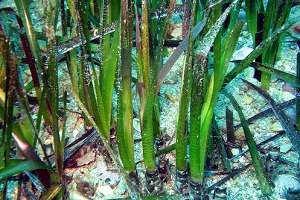Artificial anchor secures seagrass rehabilitation efforts

Murdoch University marine scientists report a successful method for re-establishing the seagrass Amphibolis antarctica at Shoalwater Bay, off Rockingham.
Dr Jennifer Verduin says it is part of a larger seagrass rehabilitation program.
"It's basically for industries to mitigate when they take away seagrass," she says.
"I'm interested in finding out how we can rehabilitate large areas where they've disappeared.
"That is why we do all these studies to actually work out which species will be best to start off with."
Dr Verduin says while viable seagrass meadows have been established in the past by replanting rhizomes of Posidonia australis, this has disadvantages.
"We're moving more with rehabilitation into using seed and seedlings so as not to damage the donor material, the donor meadows that are healthy and growing," she says.
"We should leave them as they are."
Dr Verduin says Amphibolis antarctica can be propagated without injury.
In addition to rhizomes, it produces seedlings that germinate while still attached to the adult plant, a condition called vipipary.
"It grows their young on their mother plant and then the seedlings get released," she says.
"We collect these seedlings without damaging any of the meadow."
Amphibolis seedlings have a peculiar structure called a comb, which in nature allows the plant to anchor itself under a Posidonia rhizome while it grows and takes root.
Previous attempts to plant Amphibolis seedlings using various artificial anchors have been mostly unsuccessful, as coastal storms tend to dislodge them.
However Dr Verduin's team has helped develop a steel wire anchor in the form of a 10-centimetre stake with a spiral at the head, in which the Amphibolis seedling is placed.
Seedlings planted in this way have been found to have a survival rate of 29.4 per cent after one year, and plants that survive for that long remain for an further two years, eventually attaining a mean shoot length of almost half a metre.
The steel wire then rusts away and disappears.
While acknowledging seagrasses' ecological value, Dr Verduin says it has other important functions in a developed coastline.
She describes seagrass meadows as "soft coastal engineers" which dampen waves and protect sandy coastlines from erosion.
"When you remove a lot like through boat anchorage or dredging or marina building and you remove all that seagrass it actually creates hydrodynamic differences so the water currents might be different," she says.
"Seagrasses are very important in holding our sand in place."
Provided by Science Network WA



















